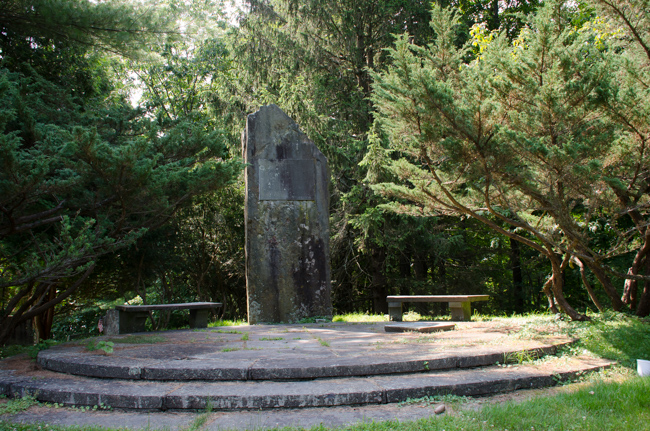Woodstock, New York
The Woodstock Artists Cemetery is officially operated by the Woodstock Memorial Society, the original 80 foot by 100 foot plot of land was purchased by John Kingsbury following the tragic death of his son. Additional land was purchased and the Woodstock Memorial Society was incorporated on November 4, 1934.
In an effort to preserve the natural beauty of the landscape, the founding members sought to limit traditional symbols of grief. As a result, conventional tombstones and other visual intrusions were prohibited. As is still the case today, graves are marked only by ground-level stones, many crafted from native bluestone.
 The Penning sculpture stands at the highest point of the hill. The poem, penned by Dr. Richard Shotwell reads: “Encircled by the everlasting hills they rest here who added to the beauty of the world by art, creative thought and by life itself.”
The Penning sculpture stands at the highest point of the hill. The poem, penned by Dr. Richard Shotwell reads: “Encircled by the everlasting hills they rest here who added to the beauty of the world by art, creative thought and by life itself.”
Tomas Penning was president of Woodstock Artist Association
Called the “Bluestone Master” because of his bold sculpture carvings, Tomas Penning was born in Glidden, Wisconsin and studied in Duluth, Minnesota, the Art Institute of Chicago and with Alexander Archipenko in Woodstock, New York.
In Woodstock, he and his wife ran the Sawgill Gallery with several other couples. During the Depression, he designed the craft-training center run by the National Youth Administration, and the Woodstock School of Art (once called Byrdcliffe) was later housed there.
Penning sculptured a Memorial for Thomas Edison, and has works in schools, and collections across the Country
 Shotwell was a Columbia professor, who attended the Paris Peace Conference at the end of World War I and helped draft the United Nations Charter after World War II.
Shotwell was a Columbia professor, who attended the Paris Peace Conference at the end of World War I and helped draft the United Nations Charter after World War II.
The only other above ground structure permitted is the memorial honoring the life of Byrdcliffe founder Ralph Whitehead and his family. Woodstock became a draw for artists in 1902 because of Byrdcliffe, which was one of the country’s first intentional arts communities.
The Della Robbia on the memorial was brought to the United States, and finally Woodstock by Whitehead himself.
The cemetery is the final resting place for artists as diverse as Robert Koch, the Academy-Award-winning screenwriter of Casablanca; American modernist painter Milton Avery; WPA muralist Ethel Magafan, children’s book author Paula Danziger; and pianist Richard Tee, who played on Paul Simon’s “Slip Slidin’ Away.”
The legacy of some artists buried there has endured while the names of others, once well known, have become obscure, such as this grave of Clinton Woodbridge Parker.

Gertrude Ross Jarvis owned an art gallery in Woodstock

Bolton Brown, carved his own birth and death years (as he felt the end approaching) into a boulder for his grave marker.
Brown was an artist, Lithographer, and Mountaineer. Brown was one of the founders of the Byrdcliffe Colony. He attended Syracuse University, Syracuse, New York, where he received his Master’s Degree in Painting. In 1891 he moved to Stanford, California to create the Art Department at Stanford University and was head of the department for almost ten years, but was dismissed in a dispute over his use of nude models in the classroom. Mount Bolton Brown in the California Sierras, is named in his honor.



[…] the husband and wife team of Jane Byrd McCall and Ralph Radcliffe Whitehead along with colleagues, Bolton Brown (artist) and Hervey White (writer). It is the oldest operating Arts and Crafts Colony in America. […]